Analysis of Theories on Human Language Emergence for Teachers
VerifiedAdded on 2022/09/16
|5
|1188
|66
Report
AI Summary
This report provides a comparative analysis of three key theories of human language emergence: cognitive theory, socio-cultural theory, and affective theories. The report explores the core tenets of each theory, examining how cognitive development, social and cultural contexts, and emotional factors influence language acquisition in early childhood. Cognitive theory, as discussed by Thorndike and Piaget, emphasizes the role of cognitive readiness and environmental experiences in language learning. Socio-cultural theories highlight the importance of social and cultural environments in shaping language development, with a focus on the role of cultural practices and social interactions. Affective theories underscore the significance of motivation and emotional factors, such as interest and challenge, in fostering language acquisition. The report then discusses the implications of these theories for early childhood educators, suggesting how teachers can utilize these insights to create effective teaching approaches and foster language development in young learners. It emphasizes the importance of integrating cognitive, socio-cultural, and affective strategies to support language learning and create a positive learning environment.
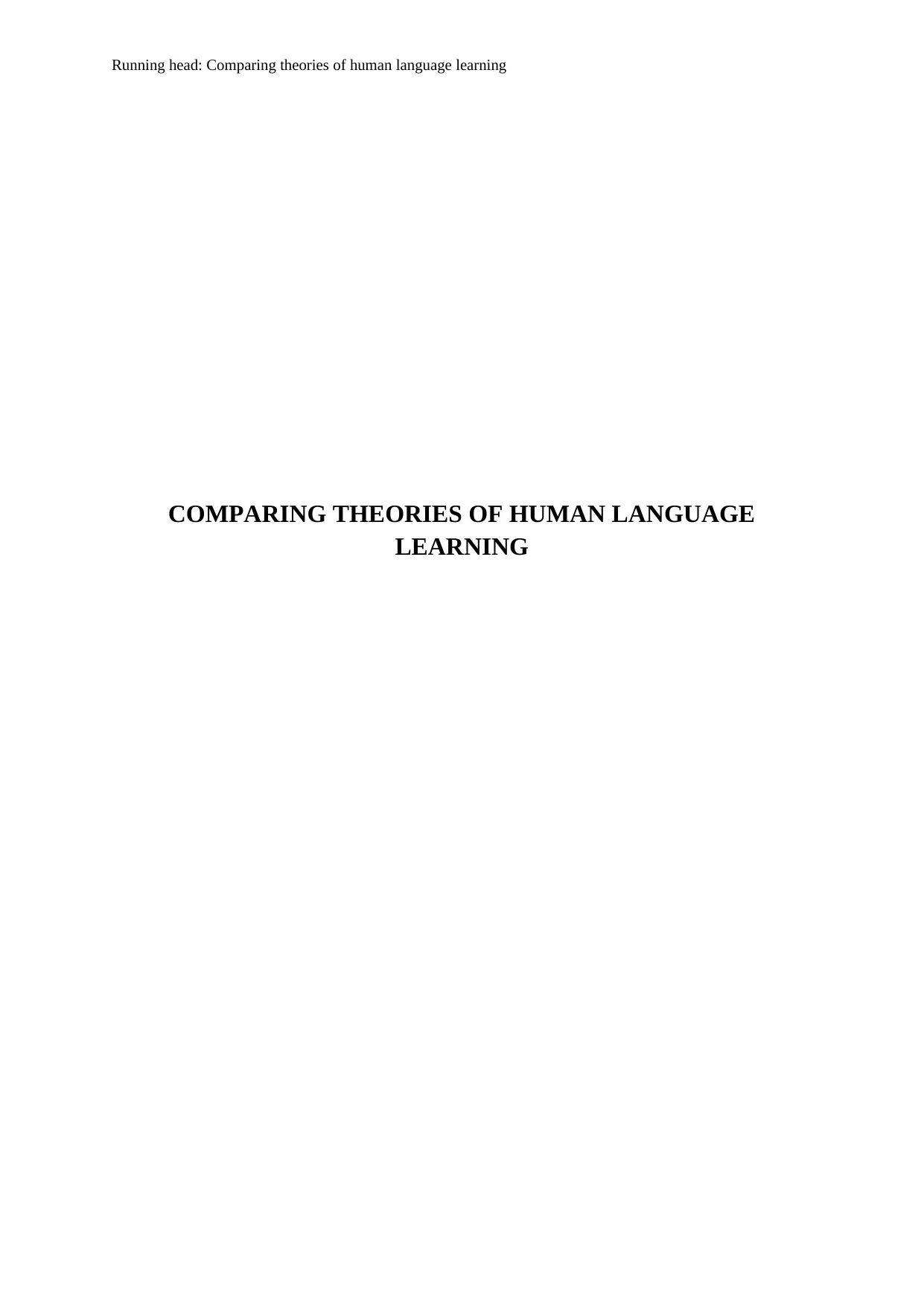
Running head: Comparing theories of human language learning
COMPARING THEORIES OF HUMAN LANGUAGE
LEARNING
COMPARING THEORIES OF HUMAN LANGUAGE
LEARNING
Paraphrase This Document
Need a fresh take? Get an instant paraphrase of this document with our AI Paraphraser
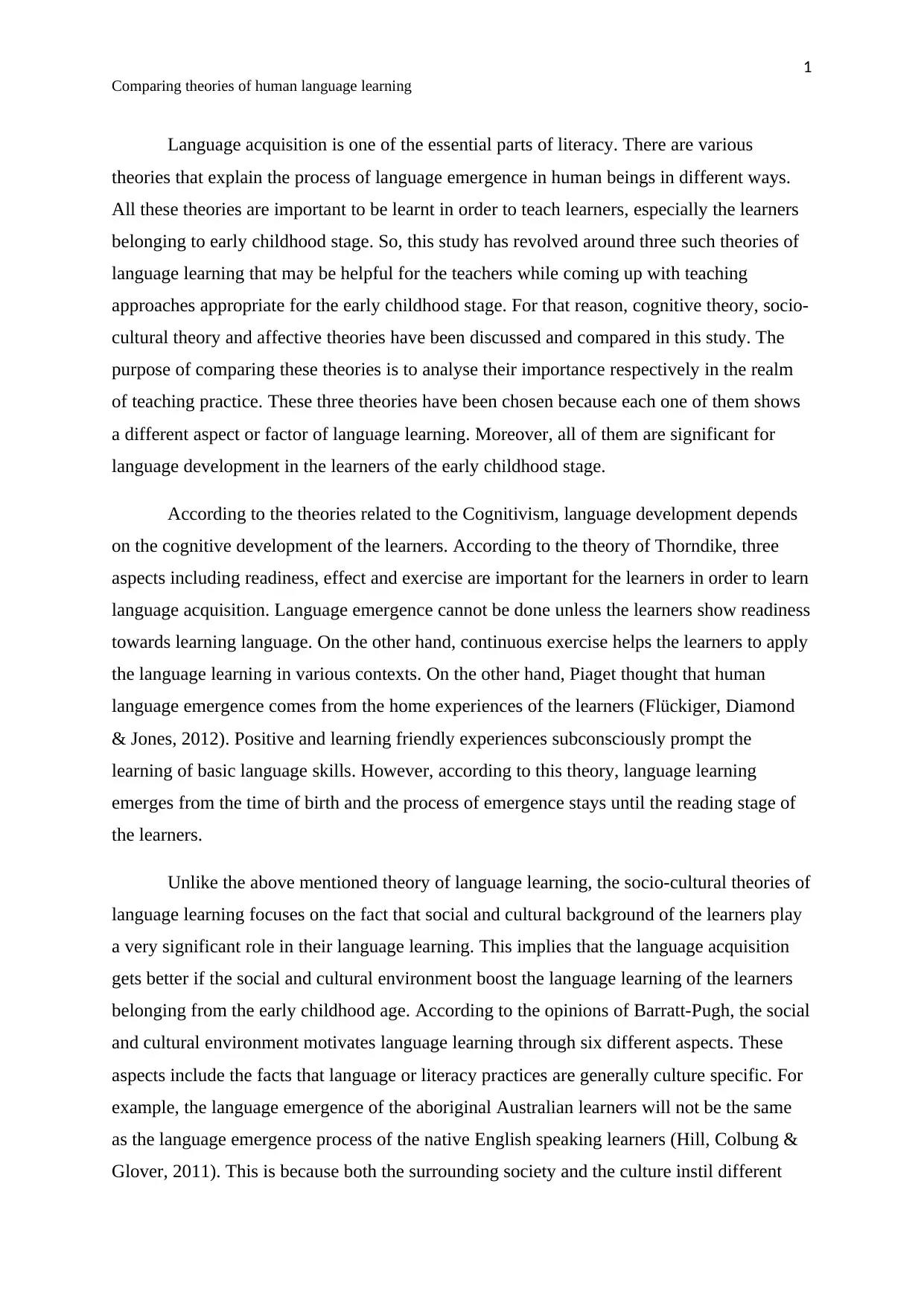
1
Comparing theories of human language learning
Language acquisition is one of the essential parts of literacy. There are various
theories that explain the process of language emergence in human beings in different ways.
All these theories are important to be learnt in order to teach learners, especially the learners
belonging to early childhood stage. So, this study has revolved around three such theories of
language learning that may be helpful for the teachers while coming up with teaching
approaches appropriate for the early childhood stage. For that reason, cognitive theory, socio-
cultural theory and affective theories have been discussed and compared in this study. The
purpose of comparing these theories is to analyse their importance respectively in the realm
of teaching practice. These three theories have been chosen because each one of them shows
a different aspect or factor of language learning. Moreover, all of them are significant for
language development in the learners of the early childhood stage.
According to the theories related to the Cognitivism, language development depends
on the cognitive development of the learners. According to the theory of Thorndike, three
aspects including readiness, effect and exercise are important for the learners in order to learn
language acquisition. Language emergence cannot be done unless the learners show readiness
towards learning language. On the other hand, continuous exercise helps the learners to apply
the language learning in various contexts. On the other hand, Piaget thought that human
language emergence comes from the home experiences of the learners (Flückiger, Diamond
& Jones, 2012). Positive and learning friendly experiences subconsciously prompt the
learning of basic language skills. However, according to this theory, language learning
emerges from the time of birth and the process of emergence stays until the reading stage of
the learners.
Unlike the above mentioned theory of language learning, the socio-cultural theories of
language learning focuses on the fact that social and cultural background of the learners play
a very significant role in their language learning. This implies that the language acquisition
gets better if the social and cultural environment boost the language learning of the learners
belonging from the early childhood age. According to the opinions of Barratt-Pugh, the social
and cultural environment motivates language learning through six different aspects. These
aspects include the facts that language or literacy practices are generally culture specific. For
example, the language emergence of the aboriginal Australian learners will not be the same
as the language emergence process of the native English speaking learners (Hill, Colbung &
Glover, 2011). This is because both the surrounding society and the culture instil different
Comparing theories of human language learning
Language acquisition is one of the essential parts of literacy. There are various
theories that explain the process of language emergence in human beings in different ways.
All these theories are important to be learnt in order to teach learners, especially the learners
belonging to early childhood stage. So, this study has revolved around three such theories of
language learning that may be helpful for the teachers while coming up with teaching
approaches appropriate for the early childhood stage. For that reason, cognitive theory, socio-
cultural theory and affective theories have been discussed and compared in this study. The
purpose of comparing these theories is to analyse their importance respectively in the realm
of teaching practice. These three theories have been chosen because each one of them shows
a different aspect or factor of language learning. Moreover, all of them are significant for
language development in the learners of the early childhood stage.
According to the theories related to the Cognitivism, language development depends
on the cognitive development of the learners. According to the theory of Thorndike, three
aspects including readiness, effect and exercise are important for the learners in order to learn
language acquisition. Language emergence cannot be done unless the learners show readiness
towards learning language. On the other hand, continuous exercise helps the learners to apply
the language learning in various contexts. On the other hand, Piaget thought that human
language emergence comes from the home experiences of the learners (Flückiger, Diamond
& Jones, 2012). Positive and learning friendly experiences subconsciously prompt the
learning of basic language skills. However, according to this theory, language learning
emerges from the time of birth and the process of emergence stays until the reading stage of
the learners.
Unlike the above mentioned theory of language learning, the socio-cultural theories of
language learning focuses on the fact that social and cultural background of the learners play
a very significant role in their language learning. This implies that the language acquisition
gets better if the social and cultural environment boost the language learning of the learners
belonging from the early childhood age. According to the opinions of Barratt-Pugh, the social
and cultural environment motivates language learning through six different aspects. These
aspects include the facts that language or literacy practices are generally culture specific. For
example, the language emergence of the aboriginal Australian learners will not be the same
as the language emergence process of the native English speaking learners (Hill, Colbung &
Glover, 2011). This is because both the surrounding society and the culture instil different
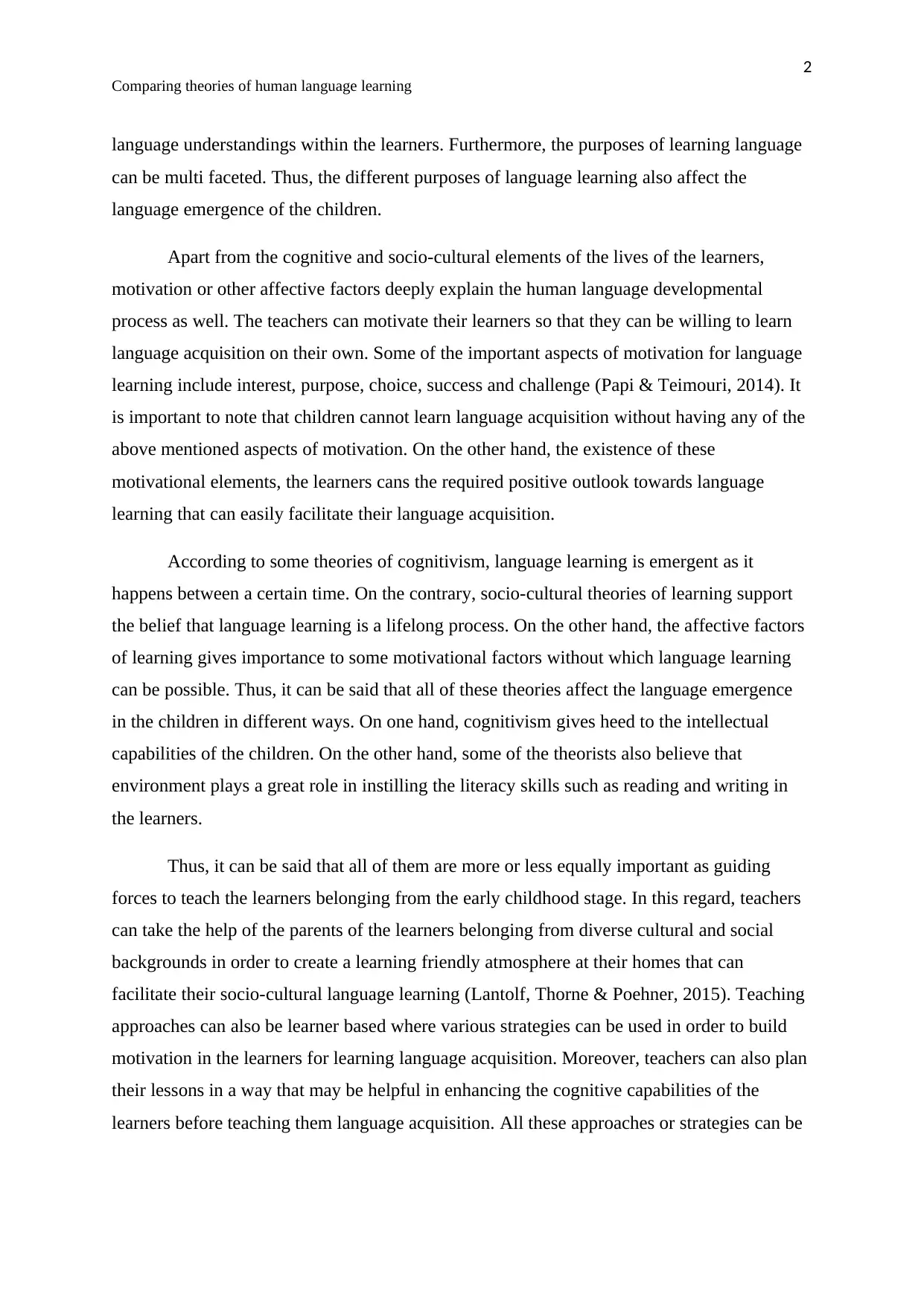
2
Comparing theories of human language learning
language understandings within the learners. Furthermore, the purposes of learning language
can be multi faceted. Thus, the different purposes of language learning also affect the
language emergence of the children.
Apart from the cognitive and socio-cultural elements of the lives of the learners,
motivation or other affective factors deeply explain the human language developmental
process as well. The teachers can motivate their learners so that they can be willing to learn
language acquisition on their own. Some of the important aspects of motivation for language
learning include interest, purpose, choice, success and challenge (Papi & Teimouri, 2014). It
is important to note that children cannot learn language acquisition without having any of the
above mentioned aspects of motivation. On the other hand, the existence of these
motivational elements, the learners cans the required positive outlook towards language
learning that can easily facilitate their language acquisition.
According to some theories of cognitivism, language learning is emergent as it
happens between a certain time. On the contrary, socio-cultural theories of learning support
the belief that language learning is a lifelong process. On the other hand, the affective factors
of learning gives importance to some motivational factors without which language learning
can be possible. Thus, it can be said that all of these theories affect the language emergence
in the children in different ways. On one hand, cognitivism gives heed to the intellectual
capabilities of the children. On the other hand, some of the theorists also believe that
environment plays a great role in instilling the literacy skills such as reading and writing in
the learners.
Thus, it can be said that all of them are more or less equally important as guiding
forces to teach the learners belonging from the early childhood stage. In this regard, teachers
can take the help of the parents of the learners belonging from diverse cultural and social
backgrounds in order to create a learning friendly atmosphere at their homes that can
facilitate their socio-cultural language learning (Lantolf, Thorne & Poehner, 2015). Teaching
approaches can also be learner based where various strategies can be used in order to build
motivation in the learners for learning language acquisition. Moreover, teachers can also plan
their lessons in a way that may be helpful in enhancing the cognitive capabilities of the
learners before teaching them language acquisition. All these approaches or strategies can be
Comparing theories of human language learning
language understandings within the learners. Furthermore, the purposes of learning language
can be multi faceted. Thus, the different purposes of language learning also affect the
language emergence of the children.
Apart from the cognitive and socio-cultural elements of the lives of the learners,
motivation or other affective factors deeply explain the human language developmental
process as well. The teachers can motivate their learners so that they can be willing to learn
language acquisition on their own. Some of the important aspects of motivation for language
learning include interest, purpose, choice, success and challenge (Papi & Teimouri, 2014). It
is important to note that children cannot learn language acquisition without having any of the
above mentioned aspects of motivation. On the other hand, the existence of these
motivational elements, the learners cans the required positive outlook towards language
learning that can easily facilitate their language acquisition.
According to some theories of cognitivism, language learning is emergent as it
happens between a certain time. On the contrary, socio-cultural theories of learning support
the belief that language learning is a lifelong process. On the other hand, the affective factors
of learning gives importance to some motivational factors without which language learning
can be possible. Thus, it can be said that all of these theories affect the language emergence
in the children in different ways. On one hand, cognitivism gives heed to the intellectual
capabilities of the children. On the other hand, some of the theorists also believe that
environment plays a great role in instilling the literacy skills such as reading and writing in
the learners.
Thus, it can be said that all of them are more or less equally important as guiding
forces to teach the learners belonging from the early childhood stage. In this regard, teachers
can take the help of the parents of the learners belonging from diverse cultural and social
backgrounds in order to create a learning friendly atmosphere at their homes that can
facilitate their socio-cultural language learning (Lantolf, Thorne & Poehner, 2015). Teaching
approaches can also be learner based where various strategies can be used in order to build
motivation in the learners for learning language acquisition. Moreover, teachers can also plan
their lessons in a way that may be helpful in enhancing the cognitive capabilities of the
learners before teaching them language acquisition. All these approaches or strategies can be
⊘ This is a preview!⊘
Do you want full access?
Subscribe today to unlock all pages.

Trusted by 1+ million students worldwide
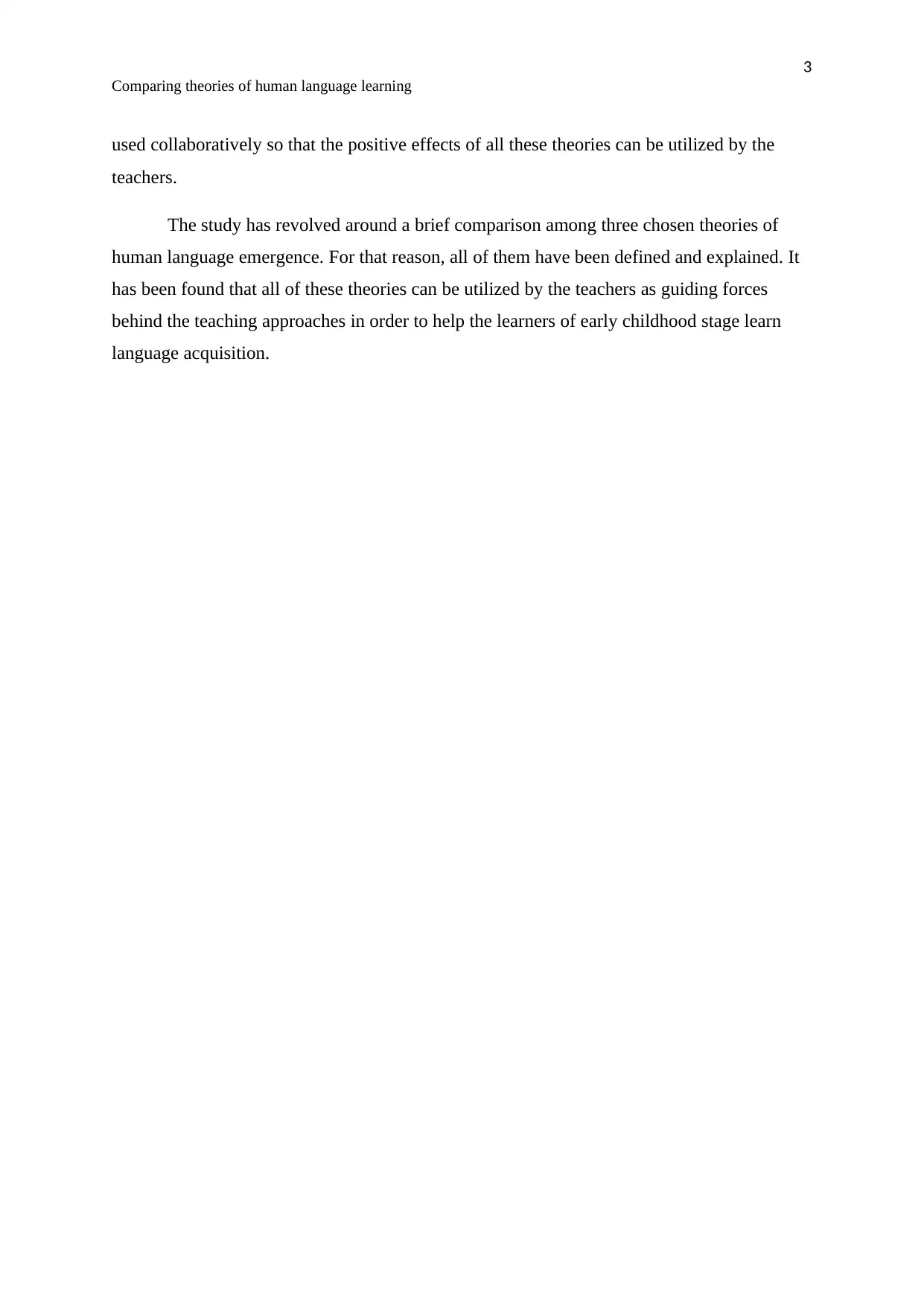
3
Comparing theories of human language learning
used collaboratively so that the positive effects of all these theories can be utilized by the
teachers.
The study has revolved around a brief comparison among three chosen theories of
human language emergence. For that reason, all of them have been defined and explained. It
has been found that all of these theories can be utilized by the teachers as guiding forces
behind the teaching approaches in order to help the learners of early childhood stage learn
language acquisition.
Comparing theories of human language learning
used collaboratively so that the positive effects of all these theories can be utilized by the
teachers.
The study has revolved around a brief comparison among three chosen theories of
human language emergence. For that reason, all of them have been defined and explained. It
has been found that all of these theories can be utilized by the teachers as guiding forces
behind the teaching approaches in order to help the learners of early childhood stage learn
language acquisition.
Paraphrase This Document
Need a fresh take? Get an instant paraphrase of this document with our AI Paraphraser
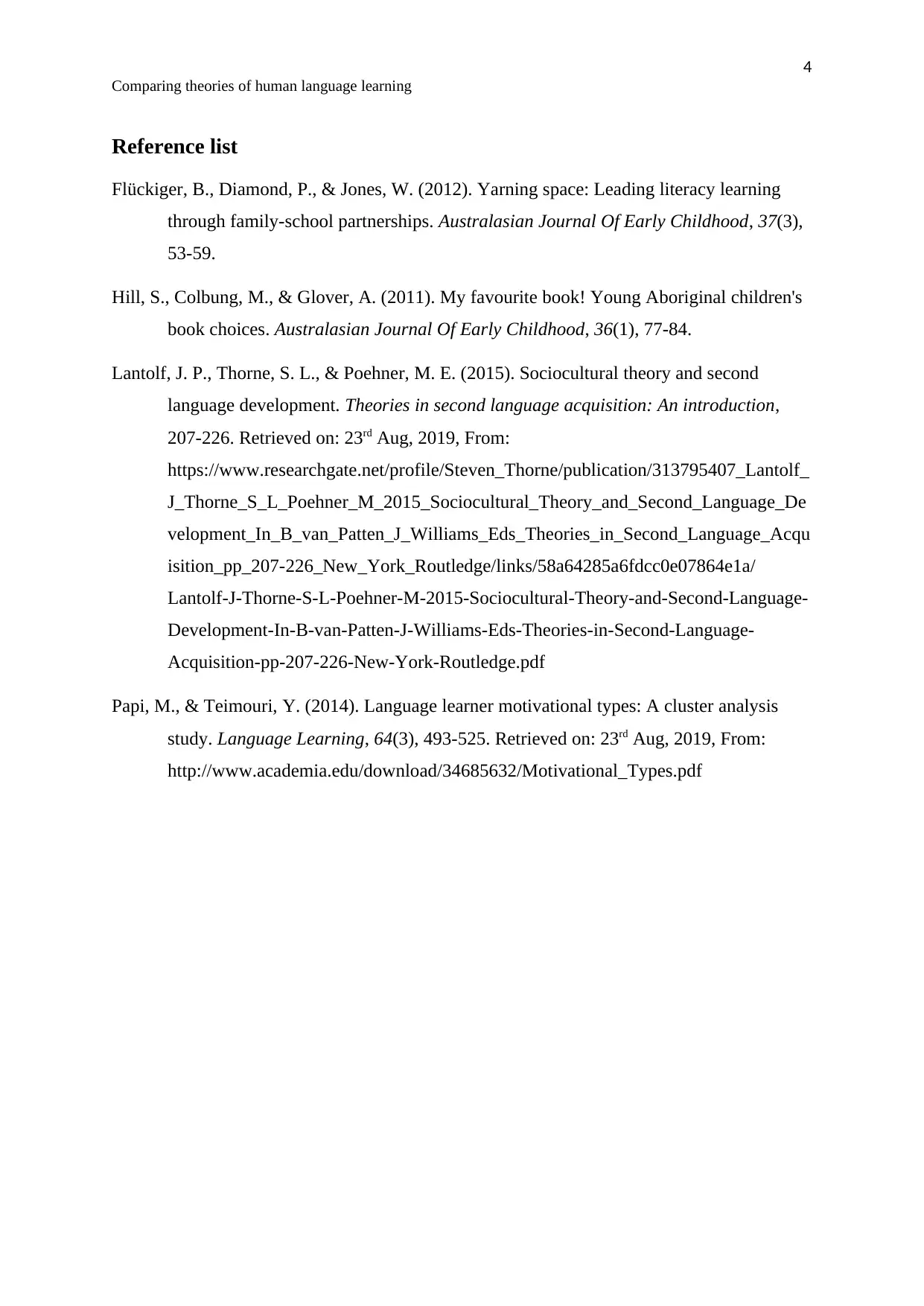
4
Comparing theories of human language learning
Reference list
Flückiger, B., Diamond, P., & Jones, W. (2012). Yarning space: Leading literacy learning
through family-school partnerships. Australasian Journal Of Early Childhood, 37(3),
53-59.
Hill, S., Colbung, M., & Glover, A. (2011). My favourite book! Young Aboriginal children's
book choices. Australasian Journal Of Early Childhood, 36(1), 77-84.
Lantolf, J. P., Thorne, S. L., & Poehner, M. E. (2015). Sociocultural theory and second
language development. Theories in second language acquisition: An introduction,
207-226. Retrieved on: 23rd Aug, 2019, From:
https://www.researchgate.net/profile/Steven_Thorne/publication/313795407_Lantolf_
J_Thorne_S_L_Poehner_M_2015_Sociocultural_Theory_and_Second_Language_De
velopment_In_B_van_Patten_J_Williams_Eds_Theories_in_Second_Language_Acqu
isition_pp_207-226_New_York_Routledge/links/58a64285a6fdcc0e07864e1a/
Lantolf-J-Thorne-S-L-Poehner-M-2015-Sociocultural-Theory-and-Second-Language-
Development-In-B-van-Patten-J-Williams-Eds-Theories-in-Second-Language-
Acquisition-pp-207-226-New-York-Routledge.pdf
Papi, M., & Teimouri, Y. (2014). Language learner motivational types: A cluster analysis
study. Language Learning, 64(3), 493-525. Retrieved on: 23rd Aug, 2019, From:
http://www.academia.edu/download/34685632/Motivational_Types.pdf
Comparing theories of human language learning
Reference list
Flückiger, B., Diamond, P., & Jones, W. (2012). Yarning space: Leading literacy learning
through family-school partnerships. Australasian Journal Of Early Childhood, 37(3),
53-59.
Hill, S., Colbung, M., & Glover, A. (2011). My favourite book! Young Aboriginal children's
book choices. Australasian Journal Of Early Childhood, 36(1), 77-84.
Lantolf, J. P., Thorne, S. L., & Poehner, M. E. (2015). Sociocultural theory and second
language development. Theories in second language acquisition: An introduction,
207-226. Retrieved on: 23rd Aug, 2019, From:
https://www.researchgate.net/profile/Steven_Thorne/publication/313795407_Lantolf_
J_Thorne_S_L_Poehner_M_2015_Sociocultural_Theory_and_Second_Language_De
velopment_In_B_van_Patten_J_Williams_Eds_Theories_in_Second_Language_Acqu
isition_pp_207-226_New_York_Routledge/links/58a64285a6fdcc0e07864e1a/
Lantolf-J-Thorne-S-L-Poehner-M-2015-Sociocultural-Theory-and-Second-Language-
Development-In-B-van-Patten-J-Williams-Eds-Theories-in-Second-Language-
Acquisition-pp-207-226-New-York-Routledge.pdf
Papi, M., & Teimouri, Y. (2014). Language learner motivational types: A cluster analysis
study. Language Learning, 64(3), 493-525. Retrieved on: 23rd Aug, 2019, From:
http://www.academia.edu/download/34685632/Motivational_Types.pdf
1 out of 5
Related Documents
Your All-in-One AI-Powered Toolkit for Academic Success.
+13062052269
info@desklib.com
Available 24*7 on WhatsApp / Email
![[object Object]](/_next/static/media/star-bottom.7253800d.svg)
Unlock your academic potential
Copyright © 2020–2025 A2Z Services. All Rights Reserved. Developed and managed by ZUCOL.




